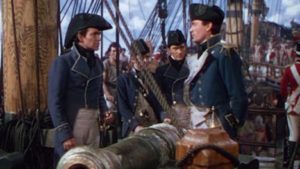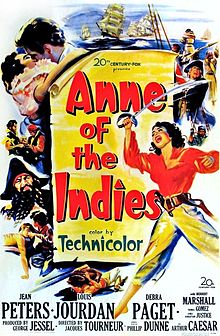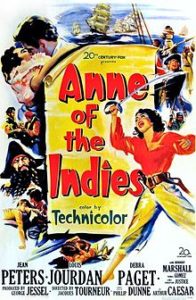Captain Horatio Hornblower
Captain Horatio Hornblower
Rating: *****
Origin: USA, 1951
Director: Raoul Walsh
Source: Warner Bros. DVD

Drawing from three of the Hornblower novels by C.S. Forester, this movie is easily the best depiction of Napoleonic-era naval warfare until, well, the British TV Hornblower adaptations in the late ‘90s. It also works as a character study, as a romance, and an unflinching reminder of the high human cost of war. Forester himself wrote the adaptation, though the script was handled by three Hollywood screenwriters. The film was originally developed as a vehicle for Errol Flynn, but after the disappointment of The Adventures of Don Juan, Flynn was passed over, and the movie stars Gregory Peck as Royal Navy Captain Hornblower. It’s a great choice: Peck, though not English, has the sort of awkward grandeur the rôle requires, formal and severe on the surface, but gnawed by doubt underneath. Hornblower wins his battles against the odds by out-thinking his opponents, and Peck deftly conveys the character’s native intelligence. Plus, he just plain looks great in a Royal Navy captain’s rig, like a statue from the Admiralty come to life.
The story is wide-ranging, from the tropical Pacific to the cold North Atlantic, and if it has a flaw it’s over-ambition, cramming in a midnight boarding expedition, a gun duel between ships of the line, a mad warlord, a jealous commodore, imprisonment and escape, a ship hijacked from port, and a surprise attack on an anchored French squadron under the guns of a cliff-top fortress—all in just under two hours. Somehow there’s still time for character development, camaraderie among the English officers, and the mourning of losses after the battles. Credit must be given to veteran director Raoul Walsh for keeping all of these elements moving swiftly and coherently without ever feeling rushed.
And we haven’t even gotten to the romance yet! The changing politics of war mean that Lady Barbara Wellesley (Virginia Mayo) needs a sudden ride out of Panama, and Hornblower’s is the only English ship for thousands of miles, so he’s stuck with carrying her around the Horn and back to England. Lady Barbara shows courage and heart by caring for the wounded during battle, Hornblower returns the favor by personally nursing her through a bout of debilitating tropical fever, and love blooms. But they’re adults with commitments, neither one is free, and obstacles must be surmounted. Mayo, who in a lightweight part could sometimes rely on her smile and phone it in, excels herself here as Lady Barbara, showing how well she can act when she’s engaged with the rôle. That, and her genuine chemistry with Peck, really make the love story work. But of course, Forester had a feel for stories of strong women romancing eccentric captains: he also wrote The African Queen. By the way, watch for Christopher Lee as a Spanish captain fighting a fierce cutlass duel with Hornblower—he’s the only guy in the movie who’s taller than Gregory Peck.

 We usually award the title Queen of the Swashbucklers to Maureen O’Hara, but Jean Peters makes a grab for her crown in this fine pirate melodrama. As an orphan girl, Anne (Peters) was raised aboard ship by Edward Teach—Blackbeard himself!—and now commands her own ship, the Sheba Queen, under the name Captain Providence. Since her brother was hanged as a pirate by the English, she preys on English shipping and kills English sailors without mercy, making the captives walk the plank. But one of these captured sailors is the strikingly-handsome Louis Jourdan playing a Frenchman named (what else?) François, who claims to be a privateer’s navigator who’d been captured by the Royal Navy. Captain Providence frees him, adds him to her crew, and takes him to Nassau to meet Blackbeard—which is where the real trouble starts.
We usually award the title Queen of the Swashbucklers to Maureen O’Hara, but Jean Peters makes a grab for her crown in this fine pirate melodrama. As an orphan girl, Anne (Peters) was raised aboard ship by Edward Teach—Blackbeard himself!—and now commands her own ship, the Sheba Queen, under the name Captain Providence. Since her brother was hanged as a pirate by the English, she preys on English shipping and kills English sailors without mercy, making the captives walk the plank. But one of these captured sailors is the strikingly-handsome Louis Jourdan playing a Frenchman named (what else?) François, who claims to be a privateer’s navigator who’d been captured by the Royal Navy. Captain Providence frees him, adds him to her crew, and takes him to Nassau to meet Blackbeard—which is where the real trouble starts.